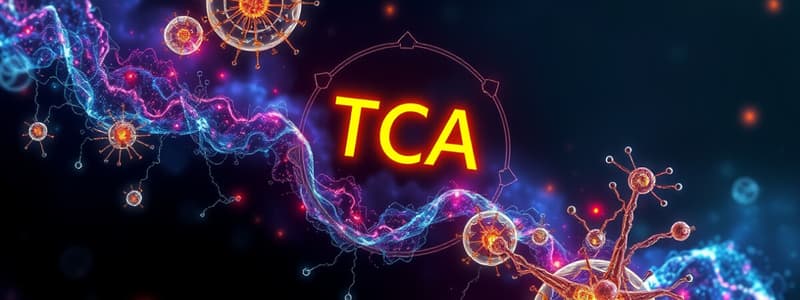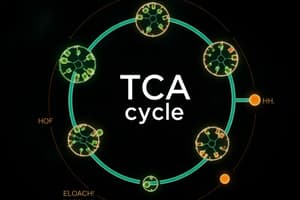Podcast
Questions and Answers
What is the primary function of the pyruvate dehydrogenase complex?
What is the primary function of the pyruvate dehydrogenase complex?
- To convert acetyl CoA to glucose
- To produce ATP from pyruvate
- To convert pyruvate into acetyl CoA (correct)
- To oxidize isocitrate to a-ketoglutarate
How many subunits make up the E1 component of pyruvate dehydrogenase in mammalian cells?
How many subunits make up the E1 component of pyruvate dehydrogenase in mammalian cells?
- 294
- 30 (correct)
- 60
- 12
What is the intermediate formed during the isomerization of citrate by aconitase?
What is the intermediate formed during the isomerization of citrate by aconitase?
- Acetyl CoA
- D-isocitrate
- Cis-aconitate (correct)
- a-ketoglutarate
Which subunit is a tetramer composed of a2b2 in the pyruvate dehydrogenase complex?
Which subunit is a tetramer composed of a2b2 in the pyruvate dehydrogenase complex?
Where are the TCA cycle enzymes located in eukaryotic cells?
Where are the TCA cycle enzymes located in eukaryotic cells?
What type of transport mechanism allows pyruvate to enter the mitochondria?
What type of transport mechanism allows pyruvate to enter the mitochondria?
Which reaction catalyzed by isocitrate dehydrogenase connects isocitrate to nitrogen metabolism?
Which reaction catalyzed by isocitrate dehydrogenase connects isocitrate to nitrogen metabolism?
What reaction occurs first in the TCA cycle involving acetyl CoA?
What reaction occurs first in the TCA cycle involving acetyl CoA?
What role does FADH2 play in the electron transport chain?
What role does FADH2 play in the electron transport chain?
What is the function of fumarase in the TCA cycle?
What is the function of fumarase in the TCA cycle?
Which product is formed from the final step of the citric acid cycle?
Which product is formed from the final step of the citric acid cycle?
Which intermediate is crucial in the synthesis of the porphyrin ring of heme groups?
Which intermediate is crucial in the synthesis of the porphyrin ring of heme groups?
How does the TCA cycle contribute to amino acid synthesis?
How does the TCA cycle contribute to amino acid synthesis?
What is the role of ubiquinone in the electron transport chain?
What is the role of ubiquinone in the electron transport chain?
Which of the following statements about malate dehydrogenase is true?
Which of the following statements about malate dehydrogenase is true?
What is a significant function of the TCA cycle aside from energy production?
What is a significant function of the TCA cycle aside from energy production?
What is the primary purpose of the TCA cycle?
What is the primary purpose of the TCA cycle?
Which of the following is NOT a direct product of the TCA cycle per one molecule of acetyl CoA?
Which of the following is NOT a direct product of the TCA cycle per one molecule of acetyl CoA?
What must occur before pyruvate can enter the TCA cycle?
What must occur before pyruvate can enter the TCA cycle?
Which enzyme catalyzes the conversion of pyruvate to acetyl-CoA?
Which enzyme catalyzes the conversion of pyruvate to acetyl-CoA?
Which of the following cofactors is produced during the conversion of pyruvate to acetyl CoA?
Which of the following cofactors is produced during the conversion of pyruvate to acetyl CoA?
Where in the cell does the TCA cycle primarily occur?
Where in the cell does the TCA cycle primarily occur?
What happens to the NADH and FADH2 produced in the TCA cycle?
What happens to the NADH and FADH2 produced in the TCA cycle?
What is the primary fuel source that generates acetyl CoA for the TCA cycle?
What is the primary fuel source that generates acetyl CoA for the TCA cycle?
Flashcards are hidden until you start studying
Study Notes
TCA Cycle Overview
- The TCA cycle, also known as the citric acid cycle or Krebs cycle, describes a series of reactions that fully oxidize sugars, fats, and proteins.
- In 1937, Sir Hans Krebs summarized existing scientific knowledge to define this cycle, with contributions from other scientists like Albert Szent-Györgyi identifying related enzymes.
Function and Products
- The cycle processes one acetyl CoA to produce:
- 2 molecules of CO2
- 3 NADH
- 1 FADH2
- 1 GTP
- The NADH and FADH2 produced are used in the electron transport chain for ATP production.
Entry into the TCA Cycle
- Pyruvate, generated from glycolysis, must be converted to acetyl CoA via the pyruvate dehydrogenase complex.
- This conversion releases CO2 and produces NADH.
Pyruvate Dehydrogenase Complex
- Catalyzes oxidative decarboxylation of pyruvate to form acetyl-CoA, found in bacterial cytosol and mitochondrial matrix.
- Composed of three subunits (E1, E2, E3); mammalian cells have a total of 294 protein subunits.
TCA Cycle Reactions
- Reaction 1: Acetyl CoA combines with oxaloacetate to form citrate, catalyzed by citrate synthase.
- Reaction 2: Aconitase converts citrate to D-isocitrate via an intermediate, cis-aconitate.
- Reaction 3: Isocitrate dehydrogenase converts isocitrate to α-ketoglutarate through oxidative decarboxylation, linking to nitrogen metabolism and glutamate synthesis.
Additional Enzymatic Steps
- Fumarase catalyzes the hydration of fumarate to form L-malate.
- Malate dehydrogenase regenerates oxaloacetate, producing NADH in the final step of the TCA cycle.
Biosynthetic Pathway Precursors
- The TCA cycle supplies intermediates for various biosynthetic pathways:
- Fatty acids synthesized from citrate.
- Amino acids derived from α-ketoglutarate via transamination.
- Purine and pyrimidine nucleotides synthesized from α-ketoglutarate and oxaloacetate.
- Gluconeogenesis conversion of oxaloacetate to glucose.
- Succinyl CoA involved in heme group synthesis.
Subcellular Localization
- In mammalian cells, TCA cycle enzymes are located in the mitochondrial matrix.
- In prokaryotic cells (e.g., E. coli), all enzymes function in the cytosol.
- Pyruvate enters mitochondria through a symporter, consuming energy during transport.
Clinical Relevance
- Understanding the TCA cycle is vital for comprehending cellular metabolism and energy production, with implications in biochemistry, physiology, and medicine.
Studying That Suits You
Use AI to generate personalized quizzes and flashcards to suit your learning preferences.




